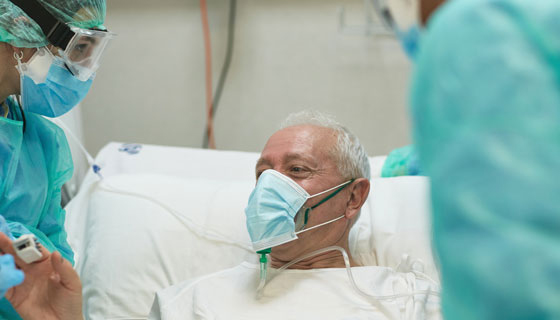Endoscopic Full Thickness Resection
If you have colon polyps or tumors such as gastrointestinal (GI) stromal tumors, your doctor may recommend removing these growths using a procedure called endoscopic full thickness resection.
What is endoscopic full thickness resection?
Endoscopic full thickness resection, or EFTR, is a minimally invasive procedure to remove (resect) benign or cancerous tumors from the gastrointestinal tract using an endoscope, a flexible, tube-like instrument.
“Full thickness” refers to how much of the gastrointestinal wall is removed. With other procedures, only the superficial layers (mucosa and submucosa) might be removed, while the EFTR procedure aims to remove deeper tissues to ensure complete tumor removal.
EFTR is typically an outpatient procedure. Many patients can go home the next day. Specially trained gastroenterologists (physicians who treat the GI tract) perform EFTR. Patients who undergo EFTR may have a shorter treatment time and faster recovery than those who have more invasive surgery.
Who may need endoscopic full thickness resection?
EFTR is very effective for removing tumors located deep in the GI wall. Because of the location of these growths, other procedures raise the risk of complications, such as tearing or perforation of tissue.
In addition to deep tumors, physicians may use EFTR for:
- Stomach, small bowel or colon polyp removal (polypectomy)
- Fistula repair: closing holes or openings between organs or tissues
- Diagnosis: helping the gastroenterologist identify the source of a problem such as pain or bleeding. EFTR can help doctors collect a tissue sample to be examined under a microscope for signs of disease (biopsy).
EFTR may be better than endoscopic mucosal resection or endoscopic submucosal dissection for safely removing tumors in the shallow layers of the GI wall that adhere to the muscle layer. In these cases, EFTR is more precise in separating the tumor from the muscle.
Types of Endoscopic Full Thickness Resection
The type of EFTR your doctor chooses is based on the size of the lesion being removed, the part of the GI tract where it is located, and in which layer of tissue it is.
Tunneled and non-tunneled EFTR
There are multiple ways to reach a tumor within a GI wall. One way is to cut above the tumor through all the layers of tissue (a non-tunneled approach). Another way is to create a tunnel to the side of the tumor through which the tumor can be extracted without making a large opening above it (a tunneled approach).
The tunneled approach is also called submucosal tunneling endoscopic resection (STER). Your doctor may choose this method to remove a growth from your esophagus or from the area where the esophagus meets the stomach. This approach can help leave the top (mucosal) layer intact and reduce the risk of leaks, infection or scarring. This method may involve less discomfort and blood loss, and a shorter hospital stay.
Exposed and non-exposed EFTR
There are multiple ways to take the tumor out. With the exposed approach, the tumor is removed first, and then the resulting opening where it used to be is closed. With a non-exposed approach, the tumor is “pinched off,” like part of a balloon animal, and separated with a staple or a clip. Then the tumor is cut off just above the staple so the opening is closed before the tumor is removed.
Non-exposed EFTR is a more common approach to certain tumors, as it minimizes bleeding and helps remove tumor cells as completely as possible.
Different Wound Closure Methods Used in EFTR
- Clip-assisted endoscopic full thickness resection. This procedure removes the lesion from the wall of the GI tract and inserts a metal clip to close the area where the tumor was removed. The clip stays inside your body.
- Standard endoscopic full thickness resection. After removing the lesion, the doctors use the endoscope to close the defect with sutures (stitches).
Preparing for Endoscopic Full Thickness Resection
Your gastroenterologist will provide detailed instructions on how to prepare for EFTR. Steps to take before the procedure may include:
- For a lower GI tract procedure, follow a liquid diet and take a laxative or enema to cleanse the bowel.
- For an upper GI tract procedure, do not eat or drink for 12 hours before the procedure.
- Tell your doctor if you have any allergies.
- Follow your doctor’s instructions about whether and when to take your prescription medications.
- Plan for someone to take you to your procedure and drive you home afterward.
What Happens During an Endoscopic Full Thickness Resection
During the procedure, your gastroenterologist and team will:
- Insert an IV into your vein and give you a sedative to make sure you don’t feel pain.
- Pass a high-definition endoscope through your mouth (for an upper GI tract procedure) or your anus (for a lower GI tract procedure).
- Observe the images of the inside of your GI tract on a screen.
- Locate and mark the edges of the tumor with a tool inserted through the endoscope.
- Use one of the surgical EFTR techniques to isolate the tumor, extract it and close the remaining opening.
- Carefully cut and remove the tumor tissue through the endoscope.
In a laboratory, a technician will examine a sample of tissue from the lesion under a microscope. The lab will confirm that the tumor was completely removed.
Endoscopic Full Thickness Resection Risks and Complications
Because these are minimally invasive procedures, the risks for EFTR complications are lower than those for laparoscopic or open procedures to remove lesions from your GI tract.
EFTR carries a small risk of:
- Incomplete removal of a cancerous lesion
- Diverticulitis
- Perforation
- Bleeding
- Infection
If your procedure takes tissue from an area near the opening of your appendix, there is an increased risk of acute appendicitis after EFTR.
Recovery After an Endoscopic Full Thickness Resection
Immediately after your procedure, you will be monitored in a recovery room while the effects of the sedative wear off. Your gastroenterologist will discuss your procedure and results with you before you leave.
After your EFTR, you may experience:
- Sore throat
- Feeling nauseated or vomiting
- Intestinal gas, bloating or cramping
- Pain in your abdomen or rectum
You will likely stay in the hospital overnight. Your doctor may limit you to clear liquids until you can have tests to ensure your EFTR procedure was a success and that there are no leaks from the site where the tumor was removed. These tests can involve an X-ray with contrast or a CT scan.
If everything looks OK, you will progress over time from a liquid diet to a soft diet over the course of a week or so, after which you can eat normally.
If tissue was removed from your stomach, you will likely be on an acid-reducing medicine for about eight weeks to help the area heal.






